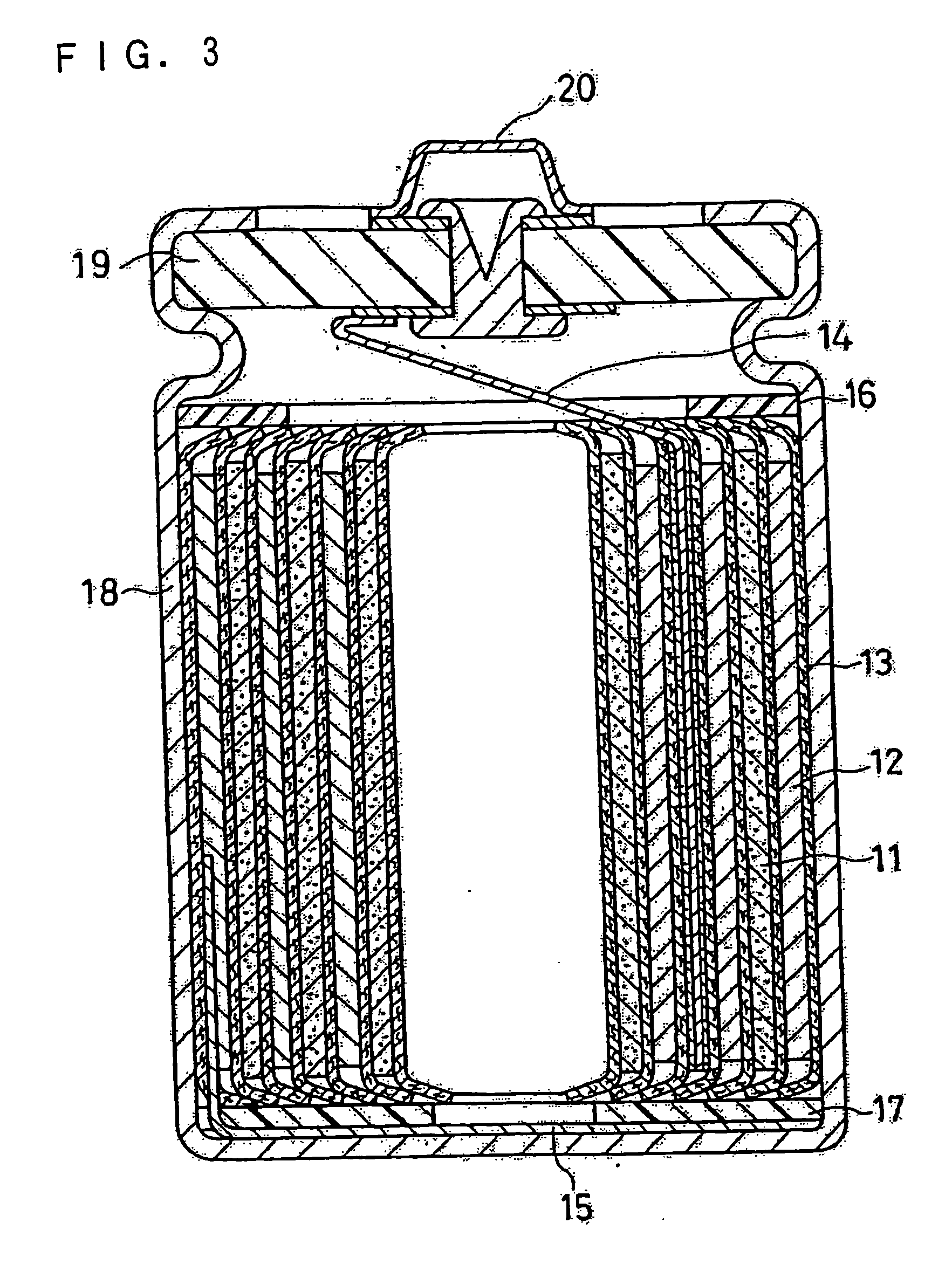Non-aqueous electrolyte secondary battery and method of producing coating for negative electrode active material thereof
a secondary battery, non-aqueous electrolyte technology, applied in the direction of non-aqueous electrolyte cells, cell components, cell component details, etc., can solve the problems that the effect intended in the above patent publication documents cannot be obtained insufficiently, damaged or broken coating on the surface of the negative electrode active material, etc., to achieve excellent charge and discharge cycle characteristics
- Summary
- Abstract
- Description
- Claims
- Application Information
AI Technical Summary
Benefits of technology
Problems solved by technology
Method used
Image
Examples
example 1
(i) Preparation of Non-Aqueous Electrolyte
[0093] LiPF6 with a concentration of 1.0 mol / L was dissolved in a solvent mixture of EC and EMC (volume ratio 1:4) to obtain a non-aqueous electrolyte. To the obtained non-aqueous electrolyte, as a first compound of a compound represented by the general formula (1) (a compound represented by the general formula (3)), 2 wt % of 1,3-butadiene or isoprene was added.
(ii) Preparation of Positive Electrode Plate
[0094] To 85 parts by weight of lithium cobaltate powder, 10 parts by weight of acetylene black as a conductive agent, and 5 parts by weight of PVDF resin as a binder were mixed. The mixture was dispersed in dehydrated N-methyl-2-pyrrolidone (hereinafter referred to as NMP) to prepare a positive electrode material mixture slurry. The positive electrode material mixture slurry was applied on a positive electrode current collector made of aluminum foil, dried, and rolled to obtain a positive electrode plate.
(iii) Preparation of Negativ...
examples 3 to 8
[0111] A non-aqueous electrolyte secondary battery was made in the same manner as Example 1, except that isoprene was added as the compound in the non-aqueous electrolyte, and the added amount was set to the amounts shown in Table 2.
[0112] Herein, only the capacity retention rate after cycles was evaluated, from among the above evaluative tests. Results are shown in Table 2.
TABLE 2CapacityAmount ofRetentionIsoprene AddedRate(wt %)(%)Example 30.169Example 4176Example 5578Example 61074Example 70.0542Example 81551
[0113] Table 2 shows that the appropriate amount of the compound to be added is 0.1 to 10 wt % relative to the non-aqueous electrolyte.
examples 9 to 15
[0114] A non-aqueous electrolyte secondary battery was made in the same manner as Example 1, except that isoprene was added as the compound in the non-aqueous electrolyte, and further, 5 mol % of the organic halide shown in Table 3 (the compound represented by general formula (2)) relative to isoprene was added.
[0115] Herein, only the capacity retention rate after cycles was evaluated, from among the above evaluative tests. Results are shown in Table 3.
TABLE 3CapacityRetentionOrganic HalideRate (%)Example 9bromoethane89Example 101-bromopropane88Example 111-chlorobutane93Example 121-bromohexane86Example 131-bromo-1,1-dimethylethane65Example 141-chlorodecane66Example 15bromobenzene63
[0116]FIG. 4 shows a reaction in which an organic halide (the compound represented by the general formula (2)) converts into an alkyl lithium compound. FIG. 5 shows a reaction in which the compound represented by the general formula (1) is polymerized with an alkyl lithium compound.
[0117] Table 3 shows...
PUM
| Property | Measurement | Unit |
|---|---|---|
| Fraction | aaaaa | aaaaa |
| Fraction | aaaaa | aaaaa |
| Fraction | aaaaa | aaaaa |
Abstract
Description
Claims
Application Information
 Login to View More
Login to View More - R&D
- Intellectual Property
- Life Sciences
- Materials
- Tech Scout
- Unparalleled Data Quality
- Higher Quality Content
- 60% Fewer Hallucinations
Browse by: Latest US Patents, China's latest patents, Technical Efficacy Thesaurus, Application Domain, Technology Topic, Popular Technical Reports.
© 2025 PatSnap. All rights reserved.Legal|Privacy policy|Modern Slavery Act Transparency Statement|Sitemap|About US| Contact US: help@patsnap.com



